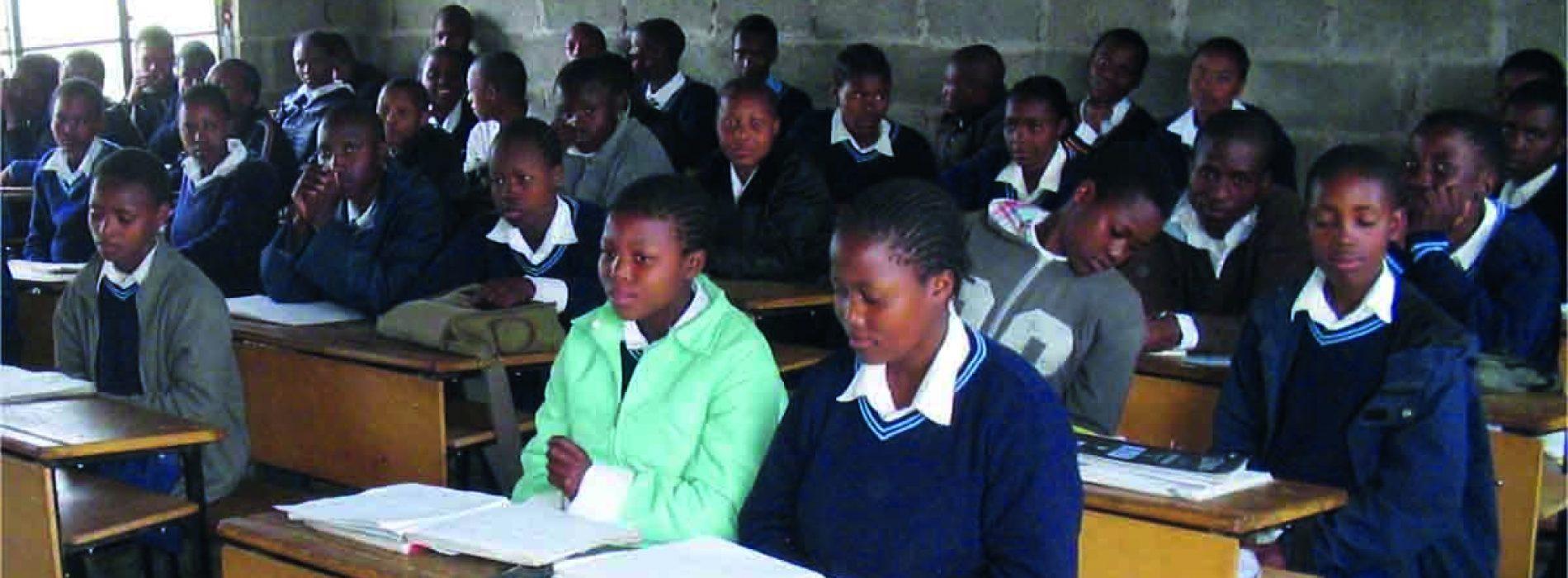Africa-Press – Lesotho. Last week the Ministry of Education and Training (MoET) announced the Lesotho General Certificate of Secondary Education’s (LGCSE) results. The results represent the climax of the twelve-year school curriculum exposer.
They are also a reflection of the quality of teaching that these students experienced over the period. In the meantime, the MoET’s 2018 Education Statistics Bulletin shows 1 461 primary schools with 10 235 teachers.
There were 25 private schools. The enrolment in these schools was 340 421. Of these, there were 1 278 (or 12.5 %) unqualified teachers. Also, the average primary school pupil-to-teacher ratio was 33.4.
The pupil-to-teacher ratio varied from district to district, with Mohale’s Hoek registering 30.1 and Mokhotlong 40 pupils per teacher. On the other hand, the total number of secondary schools in Lesotho is 347, including 12 private schools.
The total enrolment in these schools was 138 894 students with 5 353 teachers. There were 5 172 qualified teachers. The pupil-to-teacher ratio in 2018 was 26.6.
According to the MoET, over the period 2004 – 2018, the pupil-teacher ratio fluctuated between 23.5 and 26.6. The report does not disaggregate the teachers by qualifications.
The MoET does not disaggregate teachers by qualifications. This omission is crucial because teacher qualifications are one of the attributes of teacher quality.
These statistics provide a hawk-eye view of data captured for one year. Even so, it is representative of learners’ progressions from Grade 1 – Form 5.
The schooling system is highly inefficient, with 59.1% of pupils unaccounted for. On average, students take 13 – 14 years to complete 12-years of schooling.
Lesotho’s public school education portrait is very bleak, with high repeater and dropout rates. The missing teacher data paints a disheartening picture of school education in Lesotho.
This picture tells more than the data that the MoET presents. Yet, the information is available in Teaching Service Department (TSD) databases. They must use the data for recruitment.
The MoET made an unfounded assertion about teacher qualifications and pass rates. Education and politics are inextricably intertwined in ways you cannot possibly imagine.
So politics are integral to education. Attempting to divorce the two is narrow-mindedly naïve. As an illustration, schooling in Lesotho is a joint responsibility between the Government, the churches and the community.
The Government is the employer while the school board oversees its functioning, and principals and their deputies run schools. Government initiates policy and resources while the other stakeholders implement them.
When Government plans to introduce a new policy, it requires information about resources. As Morojele contends, uninformed political expediency adversely impacts the Lesotho school education.
Lesotho implemented free primary education without a proper situation analysis to determine the new policy’s resources requirements. The decision may be politically correct, but the lack of planning is yielding undesired educational consequences.
The system was ill-prepared to absorb the sudden influx of pupils. Lesotho implemented free primary education followed by the 2008 MoET’s policy. Here, the 2008 MoET policy curriculum envisaged participatory teaching and learning methods.
This article shows the shortcomings of teacher education in preparing professional teachers using an example of a primary education programme. I continue to propose a way to mitigate these impediments of teacher quality.
Constructivism theory underpins the 2008 MoET policy. Constructivists claim that students learn by actively constructing their meanings. Contrary to the policy, there are no scholarly studies that confirm constructivism with Basotho children.
The MoET Policy envisaged a particular type of teacher. They envisaged a reflective practitioner who facilitates learning in the classroom within the constructivism paradigm.
In the meantime, the MoET implemented the Revised 2019 Teachers’ Career Structure because events overtook it. The MoET listed the objectives of the system.
The two objectives that struck my attention outright are: 1. to link a teacher’s career progression to his/her performance, qualifications and experience; and
2. to enhance professionalisation by recognising the need for the development of competencies required for teaching and leadership positions;
According to the Teachers’ Career Structure, teacher qualifications and experience are critical for employment and promotion purposes. This information is crucial in the planning and recruitment of teachers.
But the information is not provided in the 2018 Education Statistics Bulletin. Even though the Ministry sought to move away from a qualification driven career structure, it continues to confine teacher quality to performance, qualification and experience measure by the number of years.
Qualifications are integral to any profession. However, the essential one is the minimum entry qualification because it is a threshold that launches a graduate into the profession.
The horizontal and vertical progressions in the Revised Structure stipulates minimum qualifications that teachers must hold. These criteria are absurd because they exclude teachers who may show competencies and skills from promotions based on a lack of paper qualifications.
This criterion is counterintuitive and counterproductive. It defeats the purpose of the structure that seeks to remove emphasis from paper qualifications.
The MoET undervalues qualitative measures of quality. Also, the MoET must define performance in the policy. The Ministry, together with stakeholders, must develop a transparent assessment matrix.
Such clarity must include classroom practices and output, in line with the 2008 MoET Policy. Experience is the best teacher in life. But, teachers’ experience must not be merely an accumulation of years in teaching.
It must establish what the teacher did in these years. It must describe the quality of the teaching experience and the quality of contributions. Teachers must add value to the profession, the school and the community.
The second bullet addresses continuous professional development (CPD). Teachers must demonstrate their participation in formal CPD activities. Teacher’s participation must bear performance-based credits points for them.
These include workshops that teachers must attend to implement new policies. Put differently, the MoET must demand teachers keep portfolios of achievements.
These portfolios must include certificates. But, they must also provide evidence of achievements and teachers’ reflections about these achievements. The MoET claims that the current oversupply of teachers indicates the success of the teaching profession competitiveness.
I beg to differ. Unemployment cannot be a measure of quality. The 2018 Education Statistics Bulletin shows 1 278 (or 12.5 %) and 181 unqualified primary and secondary school teachers, respectively, in 2018.
Contrary to the claim of competitiveness, the MoET blames unqualified teachers for poor examinations result. To understand Lesotho’s school education, I will also explore the teacher education curriculum quality.
Researchers, Lauweirier and Akkari show that teacher education in Sub-Saharan Africa offers superficial and inadequate pre-service and in-service training programmes.
Moreover, teachers work under challenging conditions, with poor pay and low morale. Lesotho teacher education studies reiterate these findings, as I shall discuss later.
Pre-service training is initial teacher training, and in-service develops teachers in schools. The succession of paragraphs contextualises teacher education in Lesotho.
Before 1975, there were seven denominational teacher training colleges in Lesotho. In 1975, the Government combined the colleges to form the Lesotho National Teachers Training College (NTTC), the predecessor to the Lesotho College of Education (LCE).
Some scholars may contend that teacher supply is one of the main constraints on both the achievement and sustainability of the education for all agenda and sustainable development goals.
But Lesotho’s context contradicts this assertion. The teacher supply-demand chain reveals that Lesotho overproduces qualified teachers. Currently, Lesotho has two prominent teacher training institutions, the LCE and the National University of Lesotho (NUL).
Botho University also offers teacher education. The LCE offers a Certificate in Early Childhood Education (CECE), a Diploma in Education (Primary) (DEP), Diploma in Education (Secondary) (DES), Diploma in Education Primary (DTEP).
DEP provides initial training for students holding a COSC. At first, the LCE was the only provider of primary teacher education. However, the situation changed.
The NUL subsequently introduced a part-time Bachelor of Education) (B Ed) (Primary). Also, NUL offers several other initial teacher education qualifications.
These are Diploma in Agriculture Education (Dip Ed Ag), BEd, Post-graduate Diploma in Education (PGDE) and Postgraduate Certificate in Education (PGCE).
This article focuses on initial teacher education. Lefoka and Sebatane presented a Country Report for the Multi-Site Teacher Education Research Project (MUSTER).
Focusing on DEP at NTTC, they characterised students who entered the DEP programme. The DEP students were chiefly female from rural areas. According to MUSTER, the students enter teacher education with unimpressive academic results.
The low achievement at COSC militates that the college training upgrades the core subject content and social life skills. Amongst the subjects with poor grades at LGCSE is English.
MUSTER expresses concern about the students’ low results in the medium of instruction which is English. The medium of instruction at the LCE is English.
Yet, the LCE was silent on how they address this challenge in their curriculum. Student teachers had taught before joining the college. The DEP curriculum did not incorporate students’ prior learning and experiences.
Students’ positive attitudes and idealism from teaching experiences could form a foundation for developing teachers. Teaching was traditionally didactic and authoritarian and lacked variety.
Students did not learn how and why they must adopt new teaching styles that encourage active learning. Without these experiences, they will replicate the traditional chalk-and-talk teaching styles that their teachers used.
In addition, students recognise that teaching is demanding with financial rewards that are not commensurate with their efforts. Still, they see teaching as a calling.
There were internal contradictions and mismatches in curriculum design, pedagogy, and students’ perceived needs. The report shows disjunctions between teaching practices in college classrooms and the approaches espoused in programmes.
Tutors did not practise student-centred approaches in classrooms. They failed to create learning situations that aid learning in the Lesotho primary school contexts.
The disjuncture in the curriculum impedes the programmes from achieving goals. They urged stakeholders to assist the college in equipping the DEP teacher educators with skills to help the college realise its aspiration through this programme.
The MUSTER study makes profound findings of DEP and Lesotho teacher education. Even though historical information on students’ profiles exists on the college database and Higher Education Management Information System (HEMIS), lecturers did not know their students.
Even worse, the college did not take advantage of existing information when designing its curriculum. This ignorance led to a mismatch between teaching and envisaged learning approaches.
MUSTER contends that the curriculum at the teacher training must incorporate all the characteristics of the student-teachers. Elsewhere, I wrote that Basotho must take full responsibility for the knowledge they produce, decontextualise into curriculum and present in the classroom.
For this to happen, a Mosotho student must be at the centre. The findings by MUSTER are clear evidence for the need. And the college does not put their students at the centre of their curriculum.
In summary, this article reflects on the MoET’s Revised Teachers’ Career Structure and MUSTER multi-national study. I showed that while most primary school teachers were qualified, a significant sum remains unqualified.
This is crucial, bearing in mind that the primary school lays the foundation for all children’s education. Politicians continue to make policy pronouncements that are not backed by research.
In this case, the existing resources, human and physical, cannot support their new policies. Politicians fail to learn from history. The Revised Career Structure seeks to diminish the over-reliance on qualification for progression practices but fails.
It contradicts itself. I argue that minimum qualifications are the entry point for any profession. Even so, qualifications must not be a tool for gatekeeping and prevention of career progression.
The policy must give CPD and attrition the prominence they deserve in teacher career progression. I suggest that the 2019 Revised Career Structure must employ teacher portfolio assessments, including evaluation matrices.
This portfolio must include descriptions of teacher experiences in terms of their quality experience and CPD. The MUSTER studies found disconnections in the curriculum, the tutoring staff, the student-teachers and the Lesotho primary schools teaching and learning contexts.
DEP is not fit for purpose because its graduates are not ready to teach in schools. Yet, these graduates meet the minimum requirements for Lesotho’s Revised Career Structure.
The Council for Higher Education accredited the DEP programme curriculum. Nevertheless, the Government must receive value for the money they invest in teachers’ salaries.
I propose something that will raise eyelids in some quarters. I suggest that Lesotho fully professionalises teaching. This time, graduates must participate in professionally supervised training placement under an independent teaching professional body.
Professions like law, medicine, and accountancy follow this protocol. At the end of the period, associate teachers take professional examinations that make them eligible for entry into the teaching profession.
Successful candidates may then register as teachers with the TSD. Alternatively, all first-time teacher training graduates entering the profession must take a professional examination administered under an independent teaching professional body.
The outcome of this examination shall determine their eligibility to enter the profession. In addition, teachers must regularly attend CPD short workshops and be evaluated for the continued practice in schools.
So, The CPD information must be part of promotion evaluations. Some countries practise this system. The process will, as a result, circumvents the challenges highlighted in the articles.
This will ensure that teachers have cutting edge expertise that evolves with the demands of changing circumstances. In conclusion, yes, my proposal is ambitious and incurs financial costs. But the benefits outweigh the costs. The Government can entrust the country’s future into the hands of professional, competent teachers.
For More News And Analysis About Lesotho Follow Africa-Press






